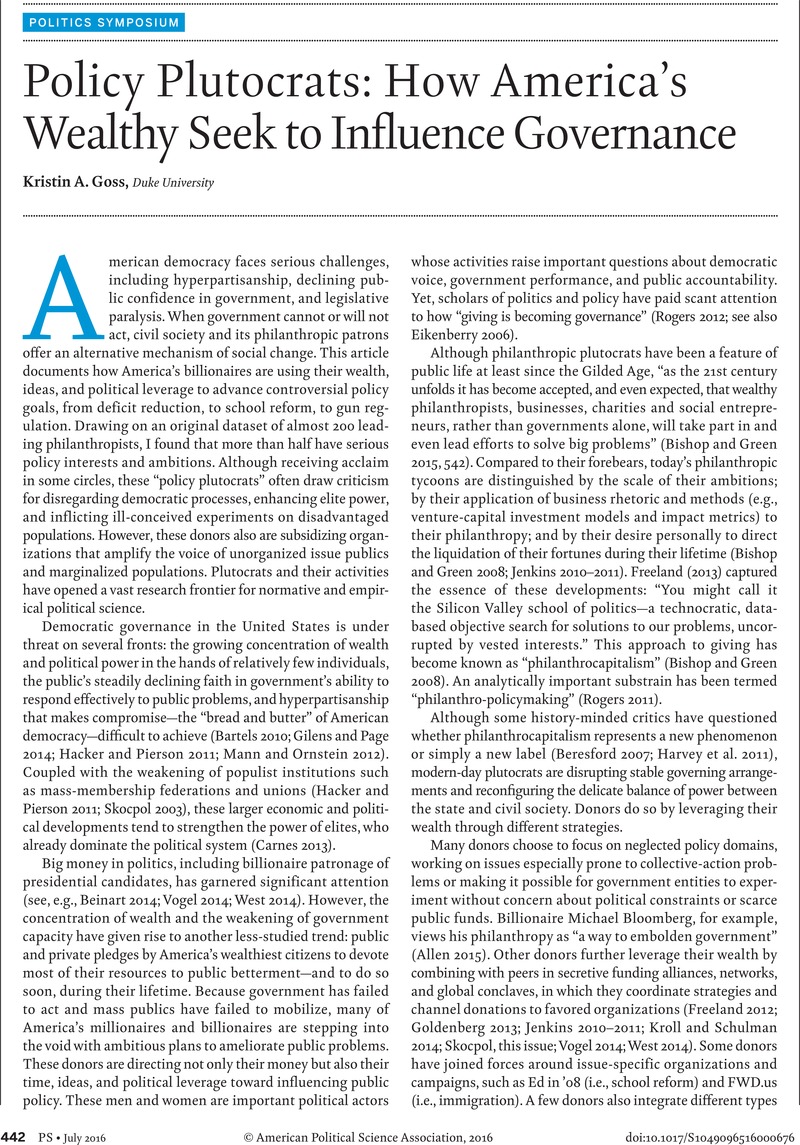Crossref Citations
This article has been cited by the following publications. This list is generated based on data provided by Crossref.
Phillips, Susan D.
2018.
Dancing with giraffes: Why philanthropy matters for public management.
Canadian Public Administration,
Vol. 61,
Issue. 2,
p.
151.
McGoey, Linsey
and
Thiel, Darren
2018.
Charismatic violence and the sanctification of the super-rich.
Economy and Society,
Vol. 47,
Issue. 1,
p.
111.
Wiist, William H.
2018.
Public Health and Corporate Avoidance of U.S. Federal Income Tax.
World Medical & Health Policy,
Vol. 10,
Issue. 3,
p.
272.
Thompson, Carol
2018.
Philanthrocapitalism: rendering the public domain obsolete?.
Third World Quarterly,
Vol. 39,
Issue. 1,
p.
51.
Goss, Kristin A.
Barnes, Carolyn
and
Rose, Deondra
2019.
Bringing Organizations Back In: Multilevel Feedback Effects on Individual Civic Inclusion.
Policy Studies Journal,
Vol. 47,
Issue. 2,
p.
451.
Arrigoni, Paola
Bifulco, Lavinia
and
Caselli, Davide
2020.
Perché e come studiare la filantropia.
Quaderni di Sociologia,
Vol. 82,
Issue. LXIV,
p.
3.
Webb Farley, Kathryn E.
and
Olejarski, Amanda M.
2020.
Mega-Gifts: Hijacking Administrative Discretion?.
Public Integrity,
Vol. 22,
Issue. 6,
p.
525.
Shanks, Delphia
and
SoRelle, Mallory E.
2021.
The paradox of policy advocacy: philanthropic foundations, public interest groups, and second-order policy feedback effects.
Interest Groups & Advocacy,
Vol. 10,
Issue. 2,
p.
137.
Haydon, Steph
Jung, Tobias
and
Russell, Shona
2021.
‘You've Been Framed’: A critical review of academic discourse on philanthrocapitalism.
International Journal of Management Reviews,
Vol. 23,
Issue. 3,
p.
353.
McGoey, Linsey
2021.
Philanthrocapitalism and the Separation of Powers.
Annual Review of Law and Social Science,
Vol. 17,
Issue. 1,
p.
391.
Gruby, Rebecca L.
Enrici, Ashley
Betsill, Michele
Le Cornu, Elodie
and
Basurto, Xavier
2021.
Opening the black box of conservation philanthropy: A co-produced research agenda on private foundations in marine conservation.
Marine Policy,
Vol. 132,
Issue. ,
p.
104645.
Maclean, Mairi
Harvey, Charles
Yang, Ruomei
and
Mueller, Frank
2021.
Elite philanthropy in the United States and United Kingdom in the new age of inequalities.
International Journal of Management Reviews,
Vol. 23,
Issue. 3,
p.
330.
Kalfagianni, Agni
2022.
Philanthropic Foundations as Agents of Justice in Global Sustainability Governance.
Global Studies Quarterly,
Vol. 2,
Issue. 3,
Frumkin, Peter
and
Zuhlke, Samantha
2022.
International Encyclopedia of Civil Society.
p.
1.
Betsill, Michele M.
Enrici, Ashley
Le Cornu, Elodie
and
Gruby, Rebecca L.
2022.
Philanthropic foundations as agents of environmental governance: a research agenda.
Environmental Politics,
Vol. 31,
Issue. 4,
p.
684.
Irvin, Renée A.
2023.
How Dark Is It? An Investigation of Dark Money Operations in U.S. Nonprofit Political Advocacy Organizations.
Nonprofit Policy Forum,
Vol. 14,
Issue. 2,
p.
101.
Kantola, Anu
and
Vesa, Juho
2023.
Silence of the wealthy: How the wealthiest 0.1% avoid the media and resort to hidden strategies of advocacy.
European Journal of Communication,
Vol. 38,
Issue. 1,
p.
43.
Bifulco, Lavinia
and
Caselli, Davide
2023.
New philanthropy, social impact and social work: insights from the Italian case.
European Journal of Social Work,
Vol. 26,
Issue. 6,
p.
981.
Kantola, Anu
and
Kuusela, Hanna
2024.
Vanguard fantasies: The wealthy upper classes as politically spirited wealth elite establishment.
The Sociological Review,
Vol. 72,
Issue. 2,
p.
359.
McCrea, Niamh
2024.
All Things Considered, Should Egalitarian Movements Accept Philanthropic Funding?.
Res Publica,
Vol. 30,
Issue. 2,
p.
285.



